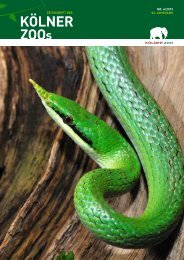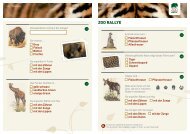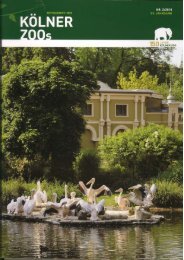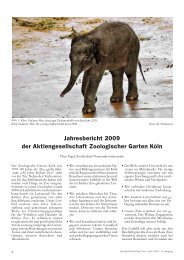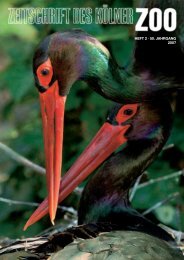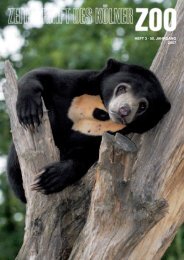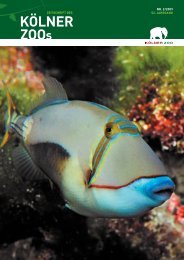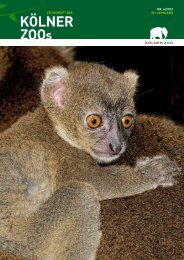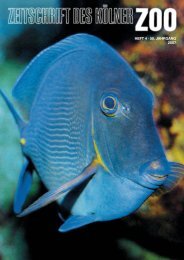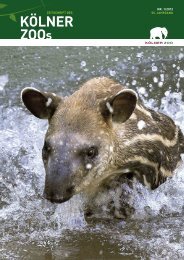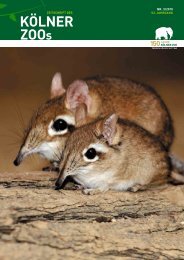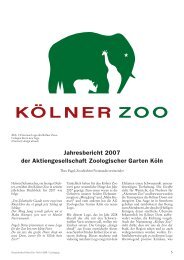Nr. 2/2012, 55. Jahrgang (PDF) - Kölner Zoo
Nr. 2/2012, 55. Jahrgang (PDF) - Kölner Zoo
Nr. 2/2012, 55. Jahrgang (PDF) - Kölner Zoo
Sie wollen auch ein ePaper? Erhöhen Sie die Reichweite Ihrer Titel.
YUMPU macht aus Druck-PDFs automatisch weboptimierte ePaper, die Google liebt.
Dr. Philip Stander and his foundation<br />
“Desert Lion Conservation” the population<br />
increased. The consecutive studies<br />
delivered valuable results, e.g. desert<br />
lions differ from lions in more mesic<br />
regions in many aspects. Increasing<br />
conflicts between lions and humans<br />
are the biggest challenge. Because of<br />
the fact that desert lions mainly live<br />
outside the strictly protected national<br />
parks in “Communal Conservancies”,<br />
they are often shot or poisoned by<br />
farmers who fear for their livestock.<br />
Trophy hunting contributes also to the<br />
dramatic decline of adult male lions<br />
during the last years so that the future<br />
of the desert lion population is uncertain<br />
again.<br />
Danksagung<br />
Mein Dank gilt Birgit Möhring, die<br />
als Vizepräsidentin der Deutsch-<br />
Namibischen Gesellschaft e.V. für<br />
den Bereich Natur- und Artenschutz<br />
zuständig ist, sowie Helmut Gries<br />
und Dr. Alexander Sliwa für das gemeinsame<br />
Engagement und die Unterstützung<br />
bei der Erstellung des<br />
Artikels.<br />
Literatur<br />
BRIDGEFORD, P. A. (1985): Unusual<br />
diet of the lion Panthera leo in the<br />
Skeleton Coast Park. Madoqua, 14:<br />
187 –188.<br />
DENKER, H. (2010/2011): Desert<br />
lions – Return of the king. Conservation<br />
and the environment in Namibia:<br />
36–38.<br />
SCHALLER, G. B. (1972): The Serengeti<br />
Lion. University of Chicago<br />
Press.<br />
SHORTRIDGE, G. C. (1934): The<br />
mammals of South West Africa.<br />
Heinemann, London. Volume 1.<br />
STANDER, P. (2006): Population<br />
ecology and demography of Kunene<br />
Lions. Research Paper 1/2006. Towards<br />
resolving human-lion conflicts<br />
with applied research and proactive<br />
management. Predator Conservation<br />
Trust. Pp. 25.<br />
STANDER, P. (2007): Behaviourecology<br />
and Conservation of desertadapted<br />
Lions. 2007 Progress report of<br />
the Kunene Lion Project, Namibia.<br />
Pp. 15.<br />
STANDER, P. (2008): Tourism and<br />
the Conservation of Desert Lions in<br />
Namibia. Desert Lion Conservation<br />
Research Report 2008. Pp. 10.<br />
STANDER, P. (2009): Movement patterns<br />
and activity of desert-adapted<br />
lions in Namibia: GPS radio collars.<br />
Desert Lion Conservation Research<br />
Report 2009. Pp. 26.<br />
Abb. 19: Männlicher Wüstenlöwe.<br />
Male desert lion. (Foto: Helmut Gries)<br />
STANDER, P. (2010): The impact of<br />
male-biased mortality on the population<br />
structure of desert-adapted lions<br />
in Namibia. Desert Lion Conservation<br />
Research Report 2010. Pp. 15.<br />
www.desertlion.info<br />
Anschrift des Verfassers:<br />
Ingo Nitsche<br />
Beselerstraße 79<br />
50354 Hürth<br />
E-Mail: Ingo.Nitsche@web.de<br />
83



